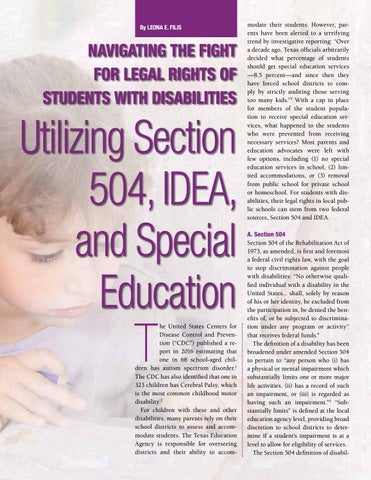By Leona E. Filis
Navigating the Fight for Legal Rights of Students with Disabilities
Utilizing Section 504, IDEA, and Special Education
T
he United States Centers for Disease Control and Prevention (“CDC”) published a report in 2016 estimating that one in 68 school-aged children has autism spectrum disorder.1 The CDC has also identified that one in 323 children has Cerebral Palsy, which is the most common childhood motor disability.2 For children with these and other disabilities, many parents rely on their school districts to assess and accommodate students. The Texas Education Agency is responsible for overseeing districts and their ability to accom-
modate their students. However, parents have been alerted to a terrifying trend by investigative reporting: “Over a decade ago, Texas officials arbitrarily decided what percentage of students should get special education services —8.5 percent—and since then they have forced school districts to comply by strictly auditing those serving too many kids.”3 With a cap in place for members of the student population to receive special education services, what happened to the students who were prevented from receiving necessary services? Most parents and education advocates were left with few options, including (1) no special education services in school, (2) limited accommodations, or (3) removal from public school for private school or homeschool. For students with disabilities, their legal rights in local public schools can stem from two federal sources, Section 504 and IDEA. A. Section 504 Section 504 of the Rehabilitation Act of 1973, as amended, is first and foremost a federal civil rights law, with the goal to stop discrimination against people with disabilities: “No otherwise qualified individual with a disability in the United States... shall, solely by reason of his or her identity, be excluded from the participation in, be denied the benefits of, or be subjected to discrimination under any program or activity” that receives federal funds.4 The definition of a disability has been broadened under amended Section 504 to pertain to “any person who (i) has a physical or mental impairment which substantially limits one or more major life activities, (ii) has a record of such an impairment, or (iii) is regarded as having such an impairment.”5 “Substantially limits” is defined at the local education agency level, providing broad discretion to school districts to determine if a student’s impairment is at a level to allow for eligibility of services. The Section 504 definition of disabil-
